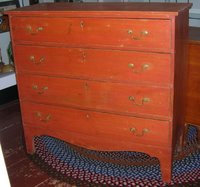
Maine can be so unique in antiques shopping. The antiques here tend to be of two categories - practical, or folky. It reflects the lifestyles of Mainers in times past (but also today too). They are hard-working people who appreciate family and home, but also have a whimsical, humorous side to them (maybe because of all those long, hard work days??) that reflects in their antiques.
For example - in just about every shop, you’ll find plenty of fine quality antique furniture. Much of it is at least one hundred years old, but there is a wide assortment of both formal and country furniture from the very early 1800s. Mainers value practicality, so furniture is well-cared for and passed through the generations, often still in it’s original finish of varnish, or early original paint. Refinished furniture does not command the attention nor the price compared to original, dry surface. Many antiques dealers actually specialize in original surface furniture.
Some shops deal only in formal furniture and accessories, while others carry only country painted pieces. It's not unusual to find shops which carry both. It all depends on the shop owner’s interests, as well as what can be found in local homes and auctions. Prices are all over the board - it’s possible to find lovely, ready-to-use furniture from 1800 to 1900 in the $350 to $1000 range, and almost always it’s of better quality than one might find in the new furniture stores.
Antique furniture was often handmade by a local craftsman a century or more ago, built by someone who understood wood, construction and usefulness. It was made with pride and resourcefulness, often of woods found in the craftsman's own home area. These are details which account for why antique furniture is still in regular use today.
Think about all the production manufactured furniture made in America during the last 30 years. Do you believe it will still be in use one hundred years from now, or will be found in an antiques shop in beautiful condition and ready for a customer's home? Maybe, but doubtful. Modern furniture, even some of the more expensive lines, is regularly made of veneer over pressboard, stapled together (much quicker than handcut dovetailing and glueing), with modern spray finishes which only hold up for a few decades, and then are difficult to restore.
Now, veneer when used as a specialty wood in a specific design, is a beautiful thing. So often these day veneer is used to make a piece of furniture look good, but the item's "bones" - the underwood beneath the veneer - is of pressboard. As an example, furniture makers in the 18th and 19th centuries crafted fabulous mahogany burled veneer as design accents, all supported underneath by hardwoods (but sometimes pine, depending on what was available locally)-. Back then, the concept of pressboard wasn't in use.
Yet regularly, quality antique furniture can be found for less money than their modern reproduction “cousins”. When clients approach me about antique furniture and are unfamiliar with a realistic price for a piece, I suggest that they first visit their local new furniture store - preferably an upper-end, fine quality store - and check that furniture for construction, finish, color, style and price. I ask them to look at the back of a chest of drawers, for example, and also view the individual drawers on the inside, to see what kind of construction was used in these modern pieces. I ask them to check for the kind of wood used - solid hardwoods throughout, or pressboard on the back and drawer interiors?
Just about any experienced antiques dealer can discuss in detail the furniture they have for sale, so comparisons are easy to do. Once a client has a good understanding of basic furniture points, they can then discuss why pieces are priced the way they are. Well-made furniture is worth investing in, and the value of an antique furniture piece will hold, even increase over the years, while newly made furniture value will not.
One of the best things about antique furniture is it’s individuality - especially in one-of-a-kind furniture that a craftsman made himself, based on his own ideas, his experience, and his design capabilities. It's even possible that this craftsman had a need for an item to fit in a specific spot in his home, so that furniture's size and form might be unusual.
Knowing that you’ve purchased a unique antique (a phrase abused much too frequently, but can easily and honestly apply in both antique furniture and folk art) adds to your own personal antique collection, and shows your personality through your selection of what speaks to you!
Tomorrow I’ll talk about antique folk art - one of Maine’s favorite specialties










No comments:
Post a Comment